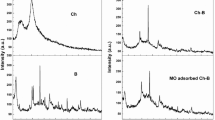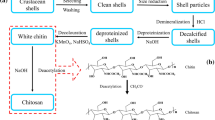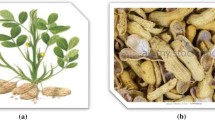Abstract
In this study, Fe3O4 nanoparticles and chitosan along with silver nanoparticles was synthesized to apply for the rapid and simple removal of amoxicillin (AMX) from aqueous environment. The characterization of fabricated adsorbent was carried out using scanning electron microscope, Energy-dispersive X-ray spectroscopy, Fourier-transform infrared spectroscopy, and X-ray diffraction analysis. Four experimental variables, including pH, contact time, adsorbent dosage, and initial AMX concentration were optimized using response surface methodology based on the central composite design. The maximum removal efficiency was obtained 89.17% with pH of 4, contact time of 40 min, adsorbent dosage of 0.4 g L−1, and initial concentration of 20 mg L−1. The effect of parameters on the removal performance was assessed using analysis of variance via the second-order polynomial model. The adsorption of AMX onto the synthesized adsorbent was more consistent with the Langmuir model with a coefficient of determination (R2) equal to 0.9991 than with the Freundlich model (R2 = 0.9165). The maximum adsorption capacity of the adsorbent was obtained 43.10 mg g−1. The pseudo-second-order kinetic model represents the most adequate correlation of empirical data compared to the pseudo-first-order (R2 = 1). The proposed adsorbent could be considered as an effective and low-cost adsorbent for the AMX removal from aqueous media.












Similar content being viewed by others
References
Sahoo SK, Padhiari S, Biswal SK, Panda BB, Hota G (2020) Fe3O4 nanoparticles functionalized GO/g-C3N4 nanocomposite: an efficient magnetic nanoadsorbent for adsorptive removal of organic pollutants. Mater Chem Phys 244:122710
García J et al (2020) A review of emerging organic contaminants (EOCs), antibiotic resistant bacteria (ARB), and antibiotic resistance genes (ARGs) in the environment: increasing removal with wetlands and reducing environmental impacts. Bioresour Technol 307:123228
Aydin S, Aydin ME, Beduk F, Ulvi A (2019) Removal of antibiotics from aqueous solution by using magnetic Fe3O4/red mud-nanoparticles. Sci Total Environ 670:539–546
Ansari M et al (2020) Dielectric barrier discharge plasma combined with nano catalyst for aqueous amoxicillin removal: performance modeling, kinetics and optimization study, energy yield, degradation pathway, and toxicity. Sep Purif Technol 251:117270
Seifollahi Z, Rahbar-Kelishami A (2019) Amoxicillin extraction from aqueous solution by emulsion liquid membranes using response surface methodology. Chem Eng Technol 42(1):156–166
Shi H et al (2020) Highly efficient removal of amoxicillin from water by three-dimensional electrode system within granular activated carbon as particle electrode. J Water Process Eng 38:101656
Boukhelkhal A et al (2016) Adsorptive removal of amoxicillin from wastewater using wheat grains: equilibrium, kinetic, thermodynamic studies and mass transfer. Desalination Water Treat 57(56):27035–27047
Shi L, Ma F, Han Y, Zhang X, Yu H (2014) Removal of sulfonamide antibiotics by oriented immobilized laccase on Fe3O4 nanoparticles with natural mediators. J Hazard Mater 279:203–211
Andreozzi R, Canterino M, Marotta R, Paxeus N (2005) Antibiotic removal from wastewaters: the ozonation of amoxicillin. J Hazard Mater 122(3):243–250
Modi A, Bellare J (2020) Amoxicillin removal using polyethersulfone hollow fiber membranes blended with ZIF-L nanoflakes and cGO nanosheets: improved flux and fouling-resistance. J Environ Chem Eng 8:103973
Matsubara ME et al (2020) Amoxicillin removal by pre-denitrification membrane bioreactor (A/O-MBR): performance evaluation, degradation by-products, and antibiotic resistant bacteria. Ecotoxicol Environ Saf 192:110258
Jung YJ et al (2012) Removal of amoxicillin by UV and UV/H2O2 processes. Sci Total Environ 420:160–167
Moarefian A, Golestani HA, Bahmanpour H (2014) Removal of amoxicillin from wastewater by self-made polyethersulfone membrane using nanofiltration. J Environ Health Sci Eng 12(1):127
Chandrasekaran A, Patra C, Narayanasamy S, Subbiah S (2020) Adsorptive removal of ciprofloxacin and amoxicillin from single and binary aqueous systems using acid-activated carbon from Prosopis juliflora. Environ Res 188:109825
Kakavandi B, Esrafili A, Mohseni-Bandpi A, Jonidi Jafari A, Rezaei Kalantary R (2013) Magnetic Fe3O4@C nanoparticles as adsorbents for removal of amoxicillin from aqueous solution. Water Sci Technol 69(1):147–155
Kerkez Ö, Bayazit Ş, Salam M (2016) Antibiotic amoxicillin removal from aqueous solution using magnetically modified graphene nanoplatelets. J Ind Eng Chem. https://doi.org/10.1016/j.jiec.2016.01.040
Shang Z et al (2020) Removal of amoxicillin from aqueous solution by zinc acetate modified activated carbon derived from reed. Powder Technol 368:178–189
Zha Sx, Zhou Y, Jin X, Chen Z (2013) The removal of amoxicillin from wastewater using organobentonite. J Environ Manage 129:569–576
Lima DR et al (2019) Removal of amoxicillin from simulated hospital effluents by adsorption using activated carbons prepared from capsules of cashew of para. Environ Sci Pollut Res 26(16):16396–16408
Limousy L, Ghouma I, Ouederni A, Jeguirim M (2017) Amoxicillin removal from aqueous solution using activated carbon prepared by chemical activation of olive stone. Environ Sci Pollut Res 24(11):9993–10004
Kang X, Liu Y, Yang C, Cheng H (2020) Removal of amoxicillin from aqueous solution using sludge-based activated carbon modified by walnut shell and nano-titanium dioxide. J Water Reuse Desalin 11(1):97–109
Jalali S, Ardjmand M, Ramavandi B, Nosratinia F (2021) Removal of amoxicillin from wastewater in the presence of H2O2 using modified zeolite Y- MgO catalyst: an optimization study. Chemosphere 274:129844
Lin C-C, Lee C-Y (2020) Adsorption of ciprofloxacin in water using Fe3O4 nanoparticles formed at low temperature and high reactant concentrations in a rotating packed bed with co-precipitation. Mater Chem Phys 240:122049
Stan M et al (2017) Removal of antibiotics from aqueous solutions by green synthesized magnetite nanoparticles with selected agro-waste extracts. Process Saf Environ Prot 107:357–372
Cai W, Weng X, Chen Z (2019) Highly efficient removal of antibiotic rifampicin from aqueous solution using green synthesis of recyclable nano-Fe3O4. Environ Pollut 247:839–846
Pourmortazavi SM, Sahebi H, Zandavar H, Mirsadeghi S (2019) Fabrication of Fe3O4 nanoparticles coated by extracted shrimp peels chitosan as sustainable adsorbents for removal of chromium contaminates from wastewater: the design of experiment. Compos Part B: Eng 175:107130
He Y et al (2020) Optimization on preparation of Fe3O4/chitosan as potential matrix material for the removal of microcystin-LR and its evaluation of adsorption properties. Int J Biol Macromol 156:1574–1583
Liu M, Zhang X, Li Z, Qu L, Han R (2020) Fabrication of zirconium (IV)-loaded chitosan/Fe3O4/graphene oxide for efficient removal of alizarin red from aqueous solution. Carbohydr Polym 248:116792
Rasool K, Lee DS (2016) Inhibitory effects of silver nanoparticles on removal of organic pollutants and sulfate in an anaerobic biological wastewater treatment process. J Nanosci Nanotechnol 16(5):4456–4463
Siddiqi KS, Husen A, Rao RAK (2018) A review on biosynthesis of silver nanoparticles and their biocidal properties. J Nanobiotechnol 16(1):14
Zhang XF, Liu ZG, Shen W, Gurunathan S (2016) Silver nanoparticles: synthesis, characterization, properties, applications, and therapeutic approaches. Int J Mol Sci 17:1534
Aksu Demirezen D, Yıldız Y, Demirezen Yılmaz D (2019) Amoxicillin degradation using green synthesized iron oxide nanoparticles: kinetics and mechanism analysis. Environ Nanotechnol Monitor Manage 11:100219
Mohd Zahri NA et al (2020) Central composite design of heavy metal removal using polymer adsorbent. J Appl Water Eng Res. https://doi.org/10.1080/23249676.2020.1831978
Kıvanç M, Yönten V (2020) A Statistical optimization of Methylene Blue removal from aqueous solutions by Agaricus campestris using multi-step experimental design with response surface methodology. Isotherm Kinetic Thermodyn Stud 18:1–8
Leili M et al (2020) Application of central composite design (CCD) for optimization of cephalexin antibiotic removal using electro-oxidation process. J Mol Liq 313:113556
Abolhasani S, Ahmadpour A, Rohani Bastami T, Yaqubzadeh A (2019) Facile synthesis of mesoporous carbon aerogel for the removal of ibuprofen from aqueous solution by central composite experimental design (CCD). J Mol Liq 281:261–268
Bhattacharya S (2021) Central composite design for response surface methodology and its application in pharmacy. Response surface methodology in engineering science. IntechOpen, London, pp 1–19
Machrouhi A, Alilou H, Farnane M, Hamidi E, Sadiq S, Abdennouri M, Tounsadi M, Barka H (2019) Statistical optimization of activated carbon from Thapsia transtagana stems and dyes removal efficiency using central composite design. J Sci 4:544–553
Farhadi S, Sohrabi M, Motiee F, Davallo M (2021) Organophosphorus diazinon pesticide removing from aqueous solution by zero-valent iron supported on biopolymer chitosan: RSM optimization methodology. J Polym Environ 29:1–18
Tomke PD, Rathod VK (2020) Facile fabrication of silver on magnetic nanocomposite (Fe3O4@Chitosan–AgNP nanocomposite) for catalytic reduction of anthropogenic pollutant and agricultural pathogens. Int J Biol Macromol 149:989–999
Shagholani H, Ghoreishi SM, Mousazadeh M (2015) Improvement of interaction between PVA and chitosan via magnetite nanoparticles for drug delivery application. Int J Biol Macromol 78:130–136
Anastopoulos I et al (2020) Removal of caffeine, nicotine and amoxicillin from (waste)waters by various adsorbents—a review. J Environ Manage 261:110236
Abdel-Aziz HM, Farag RS, Abdel-Gawad SA (2019) Carbamazepine removal from aqueous solution by green synthesis zero-valent iron/cu nanoparticles with Ficus Benjamina leaves’ extract. Int J Environ Res 13(5):843–852
Pouretedal HR, Sadegh N (2014) Effective removal of amoxicillin, cephalexin, tetracycline and penicillin G from aqueous solutions using activated carbon nanoparticles prepared from vine wood. J Water Process Eng 1:64–73
Toutounchi S, Shariati S, Mahanpoor K (2019) Synthesis of nano-sized magnetite mesoporous carbon for removal of reactive yellow dye from aqueous solutions. Appl Organomet Chem 33:e5046
Piccin JS, Dotto GL, Pinto AA (2011) Adsorption isotherms and thermochemical data of FD&C red Nº 40 binding by chitosan. Braz J Chem Eng 28:295–304
Saxena M, Sharma N, Saxena R (2020) Highly efficient and rapid removal of a toxic dye: adsorption kinetics, isotherm, and mechanism studies on functionalized multiwalled carbon nanotubes. Surf Interfaces 21:100639
Phasuphan W, Praphairaksit N, Imyim A (2019) Removal of ibuprofen, diclofenac, and naproxen from water using chitosan-modified waste tire crumb rubber. J Mol Liq 294:111554
Imanipoor J, Mohammadi M, Dinari M, Ehsani MR (2021) Adsorption and desorption of amoxicillin antibiotic from water matrices using an effective and recyclable MIL-53(Al) metal–organic framework adsorbent. J Chem Eng Data 66:389–403
Yegane Badi M, Azari A, Pasalari H, Esrafili A, Farzadkia M (2018) Modification of activated carbon with magnetic Fe3O4 nanoparticle composite for removal of ceftriaxone from aquatic solutions. J Mol Liq 261:146–154
Fazilati M (2019) Photocatalytic degradation of amoxicillin, cephalexin, and tetracycline from aqueous solution: comparison of efficiency in the usage of TiO2, ZnO, or GO–Fe3O4 nanoparticles. Desalination Water Treat 169:222–231
Adriano WS, Veredas V, Santana CC, Gonçalves LRB (2005) Adsorption of amoxicillin on chitosan beads: kinetics, equilibrium and validation of finite bath models. Biochem Eng J 27(2):132–137
Funding
The authors have not disclosed any funding.
Author information
Authors and Affiliations
Corresponding author
Ethics declarations
Conflict of interest
The authors have not disclosed any conflict of interest.
Additional information
Publisher’s Note
Springer Nature remains neutral with regard to jurisdictional claims in published maps and institutional affiliations.
Rights and permissions
About this article
Cite this article
Mahmodi Sheikh Sarmast, Z., Sedaghat, S., Derakhshi, P. et al. Facile Fabrication of Silver Nanoparticles Grafted with Fe3O4-Chitosan for Efficient Removal of Amoxicillin from Aqueous Solution: Application of Central Composite Design. J Polym Environ 30, 2990–3004 (2022). https://doi.org/10.1007/s10924-022-02402-8
Accepted:
Published:
Issue Date:
DOI: https://doi.org/10.1007/s10924-022-02402-8




